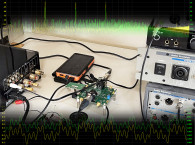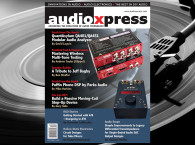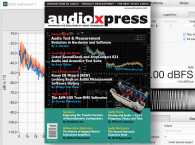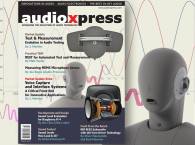For this edition of audioXpress, we suggest starting with our valuable Market Update on Audio Test and Measurement - looking at distributed testing trends and solutions for development and certification - followed by an interview and guided tour of QuantAsylum. From a practical perspective, Stuart Yaniger shares his experience with the latest version of Virtins Multi Instrument Measurement Software, Michael Steffes explains how to explore an interesting composite amplifier structure for great results, Mike Meechan continues his series on microphone preamplifier design, and Ethan Winer explains how to avoid too much wiring in large designs. And for something practical that you can build, Andrew C. Russell concludes the X-Altra MC/MM RIAA EQ Preamp DIY project, while Richard Honeycutt proposes modifications to classic, compact guitar amplifier circuits. Another great edition of audioXpress, now available to read in print and online.

As it happens every year for our March edition, audioXpress looks more carefully at the evolution of test and measurement solutions. Given the unusual circumstances of the past year, one could think that nothing very exciting had taken place, but it was quite the opposite. With many users unable to access their labs and test facilities in corporate buildings, and forced to work from home, most test and measurement companies, including those focused on audio, quickly recognized the need to accelerate and adjust their existing solutions according to these pressing concepts.
That is one of the angles that audioXpress analyzes when looking at new test and measurement solutions, where distributed testing, remote collaboration and connected measurement solutions have become vital. As audioXpress notes, for test and measurement manufacturers, this could actually mean selling more calibrated front-end instruments, while the user interface is predominantly transferred to cloud-based or connected systems, with software-as-a-service models showing also greater scalability.
In this Market Update on Audio Test and Measurement, audioXpress looks at specific solutions used for measuring electronics and acoustics, as well as development and certification solutions. Products and solutions highlighted in this edition include Pico Technology, Tektronix, Klippel, Audio Precision, Ellisys, Audiomatica, Keysight, Synopsys, Listen, Brüel & Kjær, ZUMI Systems, Loudsoft, and miniDSP.
For this edition, David Logvin interviewed Matt Taylor, the president and founder of QuantAsylum - a unique and fast growing test and measurement company based in the state of Washington - that adopted a unique modular product/solution approach that seems to be incredibly agile, adjusting well to current times. Since Logvin was unable to visit the company in person, he asked Taylor to give us a virtual tour of its activities, and share details about the company's history and vision.
Next up, Stuart Yaniger shares his more recent experiences with the latest version of Virtins Multi Instrument Measurement Software, which he combined with his RME ADI-2 Pro FS R audio interface and the Linear Audio Autoranger II to create what he defines as the Lab Bench of 2021. This is effectively a very complete solution for anyone working on product testing and evaluation from home. It is also an approach that complements Yaniger's 2015 series of audioXpress articles on how to adapt home computers and sound cards for audio test and measurement. In this article, he experiments and updates his findings and recommendations about the Multi Instrument software.
In his Audio Scope column, Michael Steffes explains how a standalone amplifier, which already has very low audio band distortion, combined with a very low noise audio preamplifier, can lower this even further in a composite amplifier structure. This is certainly an interesting approach, allowing extremely low harmonic distortion driving high powers into low audio loads, by combining the best of recent audio amplifiers with the high current output legacy ADSL current feedback line drivers.
With another deep-dive into Audio Electronics, Mike Meechan continues his article series on "The Science and Physics of High-End Mic-Preamp Design." In the first part he discussed the fundamental physics that play a primary role in microphone pre-amplifier design. This month, he focuses on "Minimizing Noise and Distortion While Maximizing Headroom," which means addressing the real practical world and what the mic pre-amp must contend with to retain the fidelity of the mic signal along its path from transducer to output.
And to provide an interesting DIY angle that all our readers can explore, Ethan Winer writes about "Clever Engineering." More specifically, he details the practical ways on how to deal with wiring techniques in order to reduce the amount needed for any given project. In his article, Winer explains how to avoid enormous amount of expensive wiring and all the potential soldering problems when designing large audio devices by using rotary encoders, serial communications, and other solutions.
 And for all our readers who started following the X-Altra Moving Coil/Moving Magnet RIAA EQ Preamplifier DIY project last month, we have the final pieces. In this edition, Andrew C. Russell details the Moving Magnet EQ stage, system gain amplifier and filters, along with the system’s power supply unit. The article concludes with some measurements. And for those eager to add this impressive design to their systems and build the X-Altra preamplifier, full PCB sets can be ordered from the author's website: http://hifisonix.com/x-altra-phono-eq-preamp.
And for all our readers who started following the X-Altra Moving Coil/Moving Magnet RIAA EQ Preamplifier DIY project last month, we have the final pieces. In this edition, Andrew C. Russell details the Moving Magnet EQ stage, system gain amplifier and filters, along with the system’s power supply unit. The article concludes with some measurements. And for those eager to add this impressive design to their systems and build the X-Altra preamplifier, full PCB sets can be ordered from the author's website: http://hifisonix.com/x-altra-phono-eq-preamp.
And this edition of audioXpress concludes with an always educative and entertaining Hollow-State Electronics article by Richard Honeycutt, this time highlighting four classics among his favorite practice guitar amplifiers - the Fender Champ, Silvertone Model 1430, Silvertone Model 1448/1457, and Vox AC4 - for which he suggests potential modern-day modifications to the basic circuits.
We know this is an edition of audioXpress that our readers will cherish and will want to keep on hand. Another prime example of audioXpress' content, published 12 times per year and available in print and online. Subscribing to the digital online version allows immediate access at: www.audioxpress.com/page/audioXpress-Subscription-Services.html
If you wish to buy a single printed issue or the complete audioXpress archive on USB, from 2000 to 2021 (yes, including the latest issue), just visit our online shop at www.cc-webshop.com
Don't miss out, get your copy of audioXpress right now at www.gotomyxpress.com






